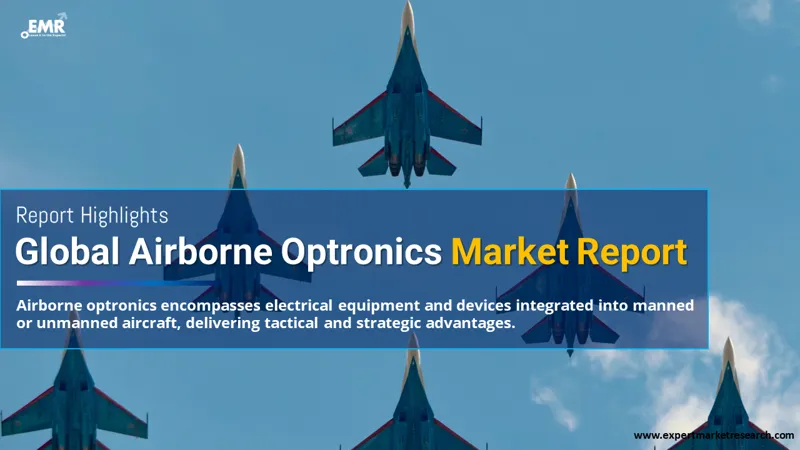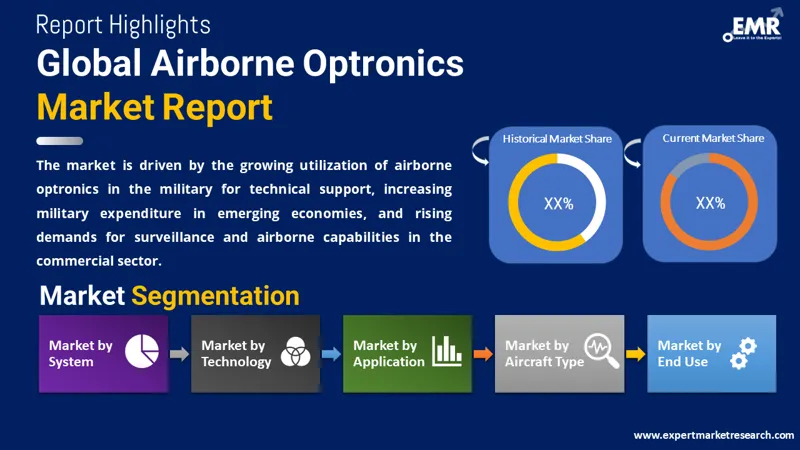
Consumer Insights
Uncover trends and behaviors shaping consumer choices today
Procurement Insights
Optimize your sourcing strategy with key market data
Industry Stats
Stay ahead with the latest trends and market analysis.
The global airborne optronics market attained a value of nearly USD 2.09 Billion in 2025. The market is projected to grow at a CAGR of 12.50% between 2026 and 2035 to reach a value of around USD 6.79 Billion by 2035.
Base Year
Historical Period
Forecast Period
Compound Annual Growth Rate
12.5%
Value in USD Billion
2026-2035
*this image is indicative*
Airborne optronics refers to the electrical equipment and devices which are integrated into manned or unmanned aircraft to provide tactical and strategic advantages. Airborne optronics can perform various functions, ranging from radio navigation to GPS-based positioning, to optimise airborne operations.

Read more about this report - REQUEST FREE SAMPLE COPY IN PDF

Read more about this report - REQUEST FREE SAMPLE COPY IN PDF
The EMR’s report titled “Airborne Optronics Market Report and Forecast 2026-2035" offers a detailed analysis of the market based on the following segments:
Market Breakup by System
Market Breakup by Technology
Market Breakup by Aircraft Type
Market Breakup by Application
Market Breakup by End Use
Market Breakup by Region
The multispectral segment accounts for a healthy share of the airborne optronics market. Multispectral airborne optronics can collect several spectral bands, providing high-resolution operational stand-off imagery to aircraft.
Over the forecast period, the anticipated increase in the adoption of multispectral drones to carry out accurate mapping, surveying, and detection of land mines and ballistic missiles is likely to fuel the growth of this segment.
The military segment accounts for a significant portion of the airborne optronics market share. The heightened use of airborne optronics in unmanned and manned aircraft to effectively track location, monitor movement, and observe targets is propelling the segment’s growth. The growing concerns pertaining to the escalating chances of cross-border conflicts and geopolitical tensions are also boosting the deployment of airborne optronics in the military sector.
The comprehensive EMR report provides an in-depth assessment of the market based on the Porter's five forces model along with giving a SWOT analysis. The report gives a detailed analysis of the key players in the global airborne optronics market report, covering their competitive landscape and latest developments like mergers, acquisitions, investments and expansion plans.
Thales Group is a global technology leader which has been actively investing in the development of digital and deep tech innovations for the aerospace, security, and space sectors, among others. The company was founded in 2000 and is headquartered in Paris, France.
Elbit Systems Ltd. is an international technology company which provides services in the field of defence and homeland security. It was established in 1966 and is currently headquartered in Haifa, Israel.
Northrop Grumman Corporation is a leading aerospace and defence company which delivers weapons and advanced military technology equipment to several end users in the space, aeronautics, defence, and cyberspace sectors. The company was established in 1994 and is headquartered in Virginia, the United States.
*Please note that this is only a partial list; the complete list of key players is available in the full report. Additionally, the list of key players can be customized to better suit your needs.*
Other market players include OSI Optoelectronics, Inc, Safran S.A., Kappa optronics GmbH, Hensoldt AG, Raytheon Technologies Corporation, Leonardo Spa, and Teledyne FLIR LLC, among others.




*While we strive to always give you current and accurate information, the numbers depicted on the website are indicative and may differ from the actual numbers in the main report. At Expert Market Research, we aim to bring you the latest insights and trends in the market. Using our analyses and forecasts, stakeholders can understand the market dynamics, navigate challenges, and capitalize on opportunities to make data-driven strategic decisions.*
Get in touch with us for a customized solution tailored to your unique requirements and save upto 35%!
The market reached a value of nearly USD 2.09 Billion in 2025.
The market is estimated to grow at a CAGR of 12.50% between 2026 and 2035.
The market is estimated to witness a healthy growth in the forecast period of 2026-2035 to reach a value of around USD 6.79 Billion by 2035.
The increasing application of airborne optronics in the military sector to provide technical assistance, increasing military expenditure of the emerging economies, and rising standards of surveillance and airborne requirements in the commercial sector are the major drivers of the market.
The key trends in the market include the rising investments by multiple governments towards building smart cities, increasing use of airborne optronics to boost situational awareness of aircraft, and growing innovations by prominent market players to provide leading-edge airborne optronics capabilities.
Reconnaissance systems, targeting systems, surveillance systems, warning/detection systems, countermeasure systems, navigation and guidance systems, and special mission systems, among others, are the different systems of airborne optronics included in the market report.
Hyperspectral and multispectral are the various segments based on technologies of airborne optronics considered in the market report.
Thales Group, Elbit Systems Ltd., Northrop Grumman Corporation, OSI Optoelectronics, Inc, Safran S.A., Kappa optronics GmbH, Hensoldt AG, Raytheon Technologies Corporation, Leonardo Spa, and Teledyne FLIR LLC, among others, are the key market players.
Explore our key highlights of the report and gain a concise overview of key findings, trends, and actionable insights that will empower your strategic decisions.
| REPORT FEATURES | DETAILS |
| Base Year | 2025 |
| Historical Period | 2019-2025 |
| Forecast Period | 2026-2035 |
| Scope of the Report |
Historical and Forecast Trends, Industry Drivers and Constraints, Historical and Forecast Market Analysis by Segment:
|
| Breakup by System |
|
| Breakup by Technology |
|
| Breakup by Aircraft Type |
|
| Breakup by Application |
|
| Breakup by End Use |
|
| Breakup by Region |
|
| Market Dynamics |
|
| Competitive Landscape |
|
| Companies Covered |
|
Single User License
One User
USD 3,999
USD 3,599
tax inclusive*
Datasheet
One User
USD 2,499
USD 2,249
tax inclusive*
Five User License
Five User
USD 4,999
USD 4,249
tax inclusive*
Corporate License
Unlimited Users
USD 5,999
USD 5,099
tax inclusive*
*Please note that the prices mentioned below are starting prices for each bundle type. Kindly contact our team for further details.*
Flash Bundle
Small Business Bundle
Growth Bundle
Enterprise Bundle
*Please note that the prices mentioned below are starting prices for each bundle type. Kindly contact our team for further details.*
Flash Bundle
Number of Reports: 3
20%
tax inclusive*
Small Business Bundle
Number of Reports: 5
25%
tax inclusive*
Growth Bundle
Number of Reports: 8
30%
tax inclusive*
Enterprise Bundle
Number of Reports: 10
35%
tax inclusive*
How To Order

Select License Type
Choose the right license for your needs and access rights.

Click on ‘Buy Now’
Add the report to your cart with one click and proceed to register.

Select Mode of Payment
Choose a payment option for a secure checkout. You will be redirected accordingly.
Gain insights to stay ahead and seize opportunities.

Get insights & trends for a competitive edge.

Track prices with detailed trend reports.

Analyse trade data for supply chain insights.

Leverage cost reports for smart savings

Enhance supply chain with partnerships.

Connect For More Information
Our expert team of analysts will offer full support and resolve any queries regarding the report, before and after the purchase.
Our expert team of analysts will offer full support and resolve any queries regarding the report, before and after the purchase.
We employ meticulous research methods, blending advanced analytics and expert insights to deliver accurate, actionable industry intelligence, staying ahead of competitors.
Our skilled analysts offer unparalleled competitive advantage with detailed insights on current and emerging markets, ensuring your strategic edge.
We offer an in-depth yet simplified presentation of industry insights and analysis to meet your specific requirements effectively.
Share